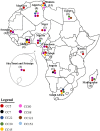Molecular epidemiology of Methicillin-resistant Staphylococcus aureus in Africa: a systematic review
- PMID: 25983721
- PMCID: PMC4415431
- DOI: 10.3389/fmicb.2015.00348
Molecular epidemiology of Methicillin-resistant Staphylococcus aureus in Africa: a systematic review
Abstract
Methicillin-resistant Staphylococcus aureus (MRSA) infections are a serious global problem, with considerable impact on patients and substantial health care costs. This systematic review provides an overview on the clonal diversity of MRSA, as well as the prevalence of Panton-Valentine leukocidin (PVL)-positive MRSA in Africa. A search on the molecular characterization of MRSA in Africa was conducted by two authors using predefined terms. We screened for articles published in English and French through to October 2014 from five electronic databases. A total of 57 eligible studies were identified. Thirty-four reports from 15 countries provided adequate genotyping data. CC5 is the predominant clonal complex in the healthcare setting in Africa. The hospital-associated MRSA ST239/ST241-III [3A] was identified in nine African countries. This clone was also described with SCCmec type IV [2B] in Algeria and Nigeria, and type V [5C] in Niger. In Africa, the European ST80-IV [2B] clone was limited to Algeria, Egypt and Tunisia. The clonal types ST22-IV [2B], ST36-II [2A], and ST612-IV [2B] were only reported in South Africa. No clear distinctions were observed between MRSA responsible for hospital and community infections. The community clones ST8-IV [2B] and ST88-IV [2B] were reported both in the hospital and community settings in Angola, Cameroon, Gabon, Ghana, Madagascar, Nigeria, and São Tomé and Príncipe. The proportion of PVL-positive MRSA carriage and/or infections ranged from 0.3 to 100% in humans. A number of pandemic clones were identified in Africa. Moreover, some MRSA clones are limited to specific countries or regions. We strongly advocate for more surveillance studies on MRSA in Africa.
Keywords: Africa; MRSA; Staphylococcus aureus; molecular epidemiology; systematic review.
Figures



References
Publication types
Grants and funding
LinkOut - more resources
Full Text Sources
Other Literature Sources

